Lard-Rendering in Photos
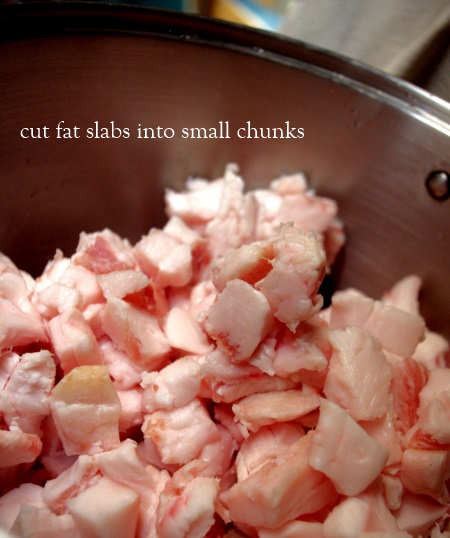
One of those lovely old-fashioned skills every respectable pioneer woman ought to know is how to render animal fat. Lard from pigs or tallow from cattle was a prized possession for those who lived off of the land. It is the cooking fat of choice for many reasons and can also be used for lighting.
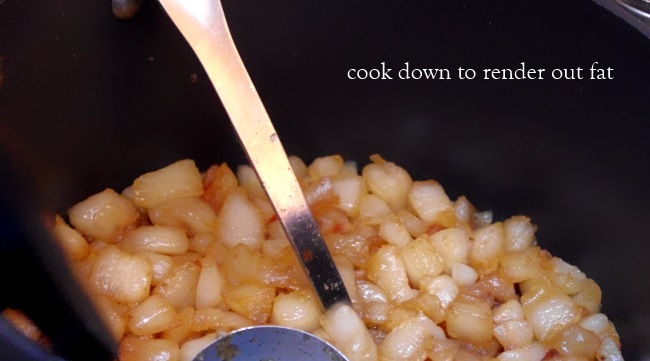
Lard was especially prolific as pigs can be raised on buckets of slop and food from your garden or grain field. We don’t have pigs yet because our garden, grain field, and slop buckets aren’t developed yet.
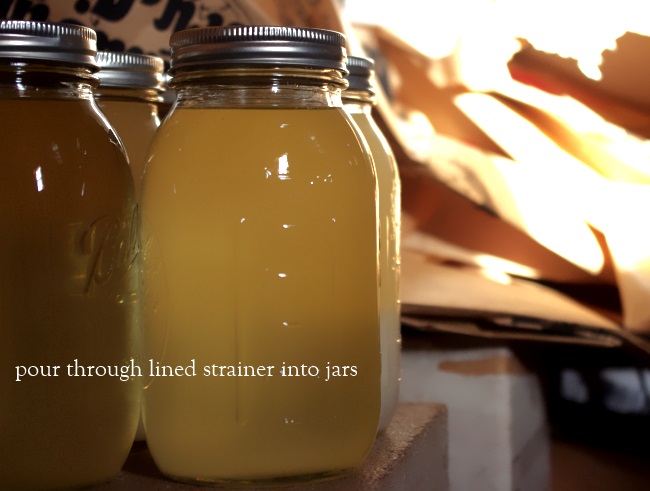
Thankfully we do have wonderful neighbors who are raising pigs. So when the words "Fat bags for sale." rang out you can bet I tried not to yell out "Sold!" too loudly, and Stewart’s ever-present fist bump followed.
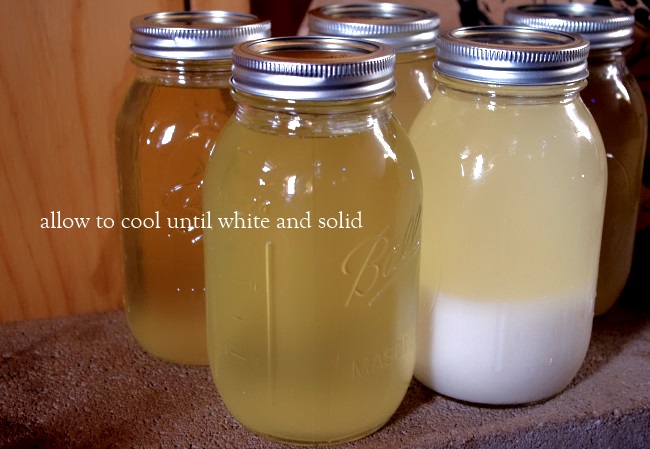
Once all of the pork was canned we got out the kitchen shears (my fat slicing implement of choice) and cut up somewhere around 40 pounds of pig fat. That rendered out to 18 beautiful quarts (4.5 gallons!) of lard which should last us a good long while.
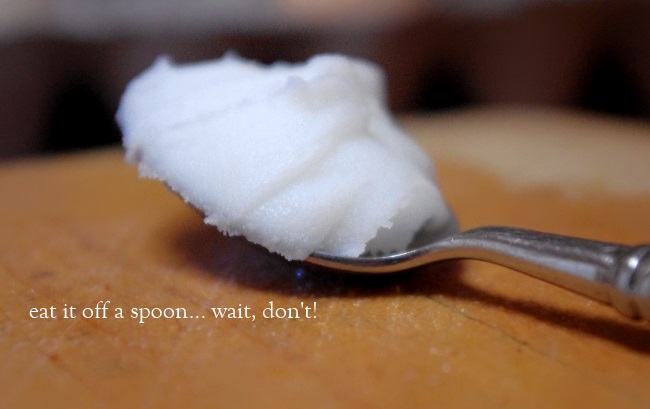
You can use it for just about everything – frying or roasting vegetables, frying meat, cooking eggs, as the shortening in biscuits or pastries, spread on toast with a sprinkling of salt, as a substitute for butter in your cookies or cake… the possibilities are endless… and so are the ways in which you can use "fat bag" in a sentence.
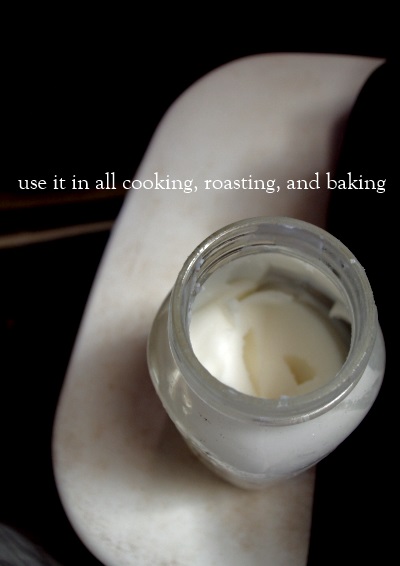
We are grateful to the Lord for providing us with fresh homegrown pork and lard and for the opportunity to practice these types of skills.

Is the liquid above the solid white lard useful for any purpose?
We raised a pig for food once while I was in elementary school. It broke out of its pen several times (though not as frequently as the adolescent goats we had at another time did). My brother and I didn’t complain about eating beef, even liver and heart, from cows that we knew, but the pork bothered us. Probably it didn’t help that we had named the pig (“Pinky”).
Lora – That jar is in the middle of the cooling process. The lard on the bottom is cooler than the liquid lard at the top. Eventually the whole jar becomes creamy white. That’s interesting about being bothered by the pork. We’re not :).
I do believe the jar you see with the solid white at the bottom and clear at the top is just at a middle stage of cooling. Given enough time all of the jars in the photo will be solid white top to bottom.
The first time I asked for lard at my butcher (a small place right on the farm) they acted like I asked them for elephant steaks. I think it was just because no one asks for it these days. They didn’t have lard, but they had frozen fat. They GAVE me 20 lbs! Lard is a beautiful thing.
Jeff – Wow, 20 lb is great! I once asked a local farmer for chicken feet (to make stock) and he literally laughed in my face and I was like “No, really.” He couldn’t believe it.
I asked to buy bones at a local butcher shop, and the butcher was completely taken aback. A customer behind me in line jumped into the conversation to help me and told him that in her native country (India) she frequently used bones to make soup.
I made several quarts of beautiful white lard awhile ago, but one of them has turned partially gray and smells very “piggy”. Is this bad, or normal? I have kept that jar in the kitchen where it isn’t very cool. The rest of it I froze and it has kept wonderfully. When you make lots of lard at once like this, how do you store it?
Hannah – Well our lard has a very faint “piggy” smell that is neither good nor bad in my opinion. 🙂 I have also stored jars of lard in the pantry and while the smell may be stronger after a period of time we’ve never had trouble with it as far as going bad enough to make someone sick. But here’s my reply regarding the keeping of lard:
I don’t have a great answer for the “how long will it keep” question since this is our first lard-rendering endeavor. I used to freeze it, which kept it for a year or two. I’ve refrigerated it, which we ate before it had a chance to get anywhere near “bad”, and I know folks who have canned it and had it indefinitely.
All of that said, before refrigeration people used to use lard or other rendered animal fat as a preservative. Think duck confit in which the meat is submerged in a crock of fat to seal it off from oxygen and bacteria. Based on that fact my theory is that it will keep as long as it keeps so long as I leave those jars sealed and in as cold of a place as we can find around here. 🙂
You can also use lard (or other fats) to make homemade soap. There are many books containing recipes available and the amount of equipment you need to make soap is minimal. You can even use up your wood ash to make the ‘lye’ which is also an ingredient in soap.
Felicity – Yes! I had totally forgotten to mention that. I just had a conversation with my dad about making soap that went something like this:
Him: “No, that doesn’t make sense. Why would you use grease to make soap?”
Me: “Dad, it’s called saponification and you use grease because that’s how you make soap.”
Him: “No, that can’t be right.”
Me: “No, really, that’s the definition of soap – it is lye mixed with fat.”
Him: “Nah, I don’t believe it.”
So anyway, thank you for the reminder!
I just found a recipe for homemade tortillas which uses lard so I thought you might like to try it sometime.
http://120dollarsfoodchallenge.com/2013/03/06/breads-and-pastries-tortillas/
I love it when we use something that is normally thrown away in our modern society and used for good.
Cheers – Joolz
Wonderful! We rendered lard for the first time just a month ago, and got around 5 gallons of precious substance! It’s white as snow and so creamy 🙂
What did you do with the leftover chunks? In Croatia we do a traditional snack called Čvarci. This you do by pressing the leftover fat chunks through a thing you make mashed potatoes with, press it really hard so you squeeze the whole fat out of it, put it in a bowl and sprinkle with salt. It holds for a long time, and is delicious and crunchy. This is a link to an image of Čvarci we did http://4.bp.blogspot.com/-5QI_S6wBinU/URALCGWsm_I/AAAAAAAAFo0/zu_WnvRVrEQ/s1600/cvarci2.jpg try it, it’s better than any other salty snack, or popcorn’s 🙂
Katija – Hi! We threw the leftover chunks to the chickens. I know people who have made cracklins which sound an awful lot like your Cvarci. I was actually going to try to get a 2nd rendering out of those chunks but we were on a time crunch and I was satisfied with what we had gotten. Your Cvarci look absolutely delicious, btw.
….”the possibilities are endless… and so are the ways in which you can use “fat bag” in a sentence.” LOL! Shannon, you crack me up! Great post and thank you for continuing to raise awareness of and bring us back to true nourishment.
Susan
Susan – Ha! Likewise on the cracking up 😉
This has been posted at a good time for me. I just rendered about 5 gallons of tallow. My question is this: now that it’s rendered, how do you store it? I’ve looked all over the web. Some places say to dry can it so it’s shelf stable, some say refrigerate so it lasts longer, other places say freeze it. I’m so confused.
Stephanie – I don’t have a great answer for the “how long will it keep” question since this is our first lard-rendering endeavor. I used to freeze it, which kept it for a year or two. I’ve refrigerated it, which we ate before it had a chance to get anywhere near “bad”, and I know folks who have canned it and had it indefinitely.
All of that said, before refrigeration people used to use lard or other rendered animal fat as a preservative. Think duck confit in which the meat is submerged in a crock of fat to seal it off from oxygen and bacteria. Based on that fact my theory is that it will keep as long as it keeps so long as I leave those jars sealed and in as cold of a place as we can find around here. 🙂
@Stephanie,
Hi Stephanie,
Back in 1997 my husband and I bought the larger half of a cow from someone we knew. When I called to tell the slaughter house how I wanted it cut up I asked if I could get some of the suet. They told me I could have all I wanted. I told them 10# sounded good. About a week later I went to pick up my meat with my husband and as the lady and I were talking, she said, Are you the lady who wanted the fat? Yep. There is is, she said, all you want!!!
In two big tubs were hunks of fat! So she gave me two big black trash can liners and I filled them up with about 100 pounds of suet! FREE suet! I thought I was going to pay a .27c handling fee for each pound, but no, I got it all FREE! Only problem was I had to place it in the bags. My husband refused to touch it. So I loaded up each bag, hubby placed them in the back of the truck, and I held my hands up till we got home as they were covered in fat.
The kids helped unload the meat and we got it in the freezer, then I began to arduous task of cutting up all the fat so it would fit in gallon freezer bags. I ended up with about 25 bags full of fat, each weighing around 4-5 pounds.
Over the course of the next few weeks, I’d cut up fat from the freezer and place it in a large pot with just a bit of water on the bottom. The water cooks out as the fat renders. The kids hated the smell, but it didn’t bother me any.
When the suet was all rendered down into tallow, I’d pour it through cheesecloth into a plastic shoe box (I let it cool some first!), and would get 3-4 boxes from each rendering. These would them go into the fridge to harden, then I’d wrap them well in plastic wrap, tape them shut with butcher tape, and stack them in the freezer. I ended up with a pile of these! They weighed 5-8 pounds each. (I have a kitchen scale.)
I made suet cakes for the birds, tallow candle, soap, and cooked with some. Most became soap or candles. And it was all totally FREE.
It took some work on my part, but was so worth it. I prefer soaps made with all vegetable oils, but I will make and use soaps made with tallow or lard, especially when I have 100 pounds or so of it sitting in my freezer just waiting to be used.
The slaughter house we went through said they got just $40 a ton (don’t know what they get now), so they didn’t mind giving me all I wanted to haul away.
I should call them and see if I can still get free fat, or maybe for a small price. Very worth it. I would not eat this fat as I would not know where it came from, but I’d make candles and soap out of it.
Thanks for the replies. I think I’ll dry seal it up in quarts. I’m going to put one in the pantry, one in the fridge, and the rest in my freezer until I figure out how it lasts best.
Oh Shannon you always make me laugh! I know that the phrase “fat bag” is going to come out of my mouth at least a dozen times today! hahaha
Amy – 🙂
How long does this keep? Must this be refrigerated or can it store on a shelf at room temperature?
Shere – I don’t have a great answer for the “how long will it keep” question since this is our first lard-rendering endeavor. I used to freeze it, which kept it for a year or two. I’ve refrigerated it, which we ate before it had a chance to get anywhere near “bad”, and I know folks who have canned it and had it indefinitely.
All of that said, before refrigeration people used to use lard or other rendered animal fat as a preservative. Think duck confit in which the meat is submerged in a crock of fat to seal it off from oxygen and bacteria. Based on that fact my theory is that it will keep as long as it keeps so long as I leave those jars sealed and in as cold of a place as we can find around here. 🙂
Shannon, I recently rendered lard from a calve butchered, how long does it keep if you do not pressure can the lard? How long will it keep in a root cellar?
Hi Pat! I don’t have a great answer for the “how long will it keep” question since this is our first lard-rendering endeavor. I used to freeze it, which kept it for a year or two. I’ve refrigerated it, which we ate before it had a chance to get anywhere near “bad”, and I know folks who have canned it and had it indefinitely.
All of that said, before refrigeration people used to use lard or other rendered animal fat as a preservative. Think duck confit in which the meat is submerged in a crock of fat to seal it off from oxygen and bacteria. Based on that fact my theory is that it will keep as long as it keeps so long as I leave those jars sealed and in as cold of a place as we can find around here. 🙂
Thanks for this, Shannon. I’ve been making soap, and thought it would be fun to try it using lard, so bought 10 pounds of fat from the farmer who also sells us our meat. It’s been in the freezer for two weeks because I’ve been intimidated to make lard. Now I’m not only going to make it, but might skip the soap and use it for cooking instead. BTW, where do you store rendered lard? Can it just stay on pantry shelves? Thanks!
I just want to add that you don’t have to strain it. Just pour it in a jar and the chunks will settle on the bottom. It means that the very end of the jar will have little pieces in it, but just don’t use that part for pastry! It’s so much better to clean up this way. Fat hardening on a strainer is not fun!
Did you use fat from all parts of the pig or did you ask for the kidney and back fat only? I’ve read before those parts made the best/white lard. I tried rendering lard once before will all fat parts and my lard didn’t turn a clear white- it was more of a cream color with a slight piggy smell.